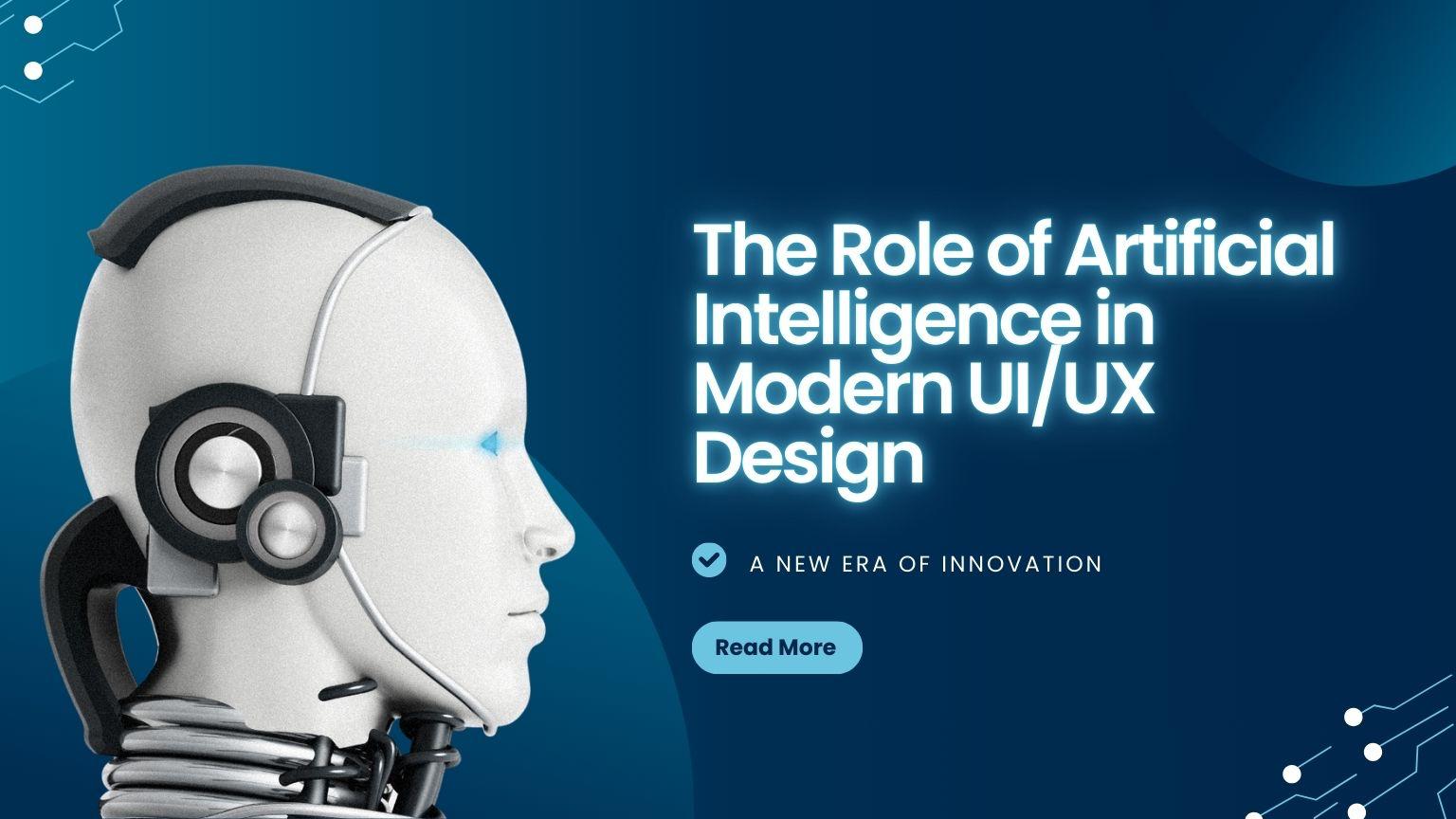The field of UI/UX design is dynamic, and so is the influence of artificial intelligence (AI) on the field, as the latest technological advancements. As AI becomes more a part of design tools and processes, designers will likely have to switch up their work very substantially. This will be both exciting and slightly unsettling.
This is because since AI can process large amounts of user data and ways of predicting behaviour, it is imperative in UI/UX. After all, the user experience becomes more engaging and simpler. This is just a layer of automation designed for building complex intelligent UI/UX, which are increasingly more responsive and flexible. Up until some time ago, human-driven insights were the cornerstone of the traditional UI/UX design.
In this article, we will explore how this will affect UI/UX design in the future and in general. Let’s welcome it as a revolutionary change.
What Does AI Mean for UX Design?
The term AI in UX design indicates using machine learning, natural language processing (NLP), and predictive analytics to create intelligent, impactful, and easy experiences for users. Years ago, this quickly developing field has already completely changed the UX design process.
However, by applying AI to user research and analysis, UX designers can come up with solutions that are largely aligned with user behaviour and preferences; they are not restricted by instinct and gut feeling anymore. AI is speeding up the entire ideation and creative process, giving designers more ideas in less time by producing design variations, inspiration, and content quickly.
The Advancements in Design Due To AI
The success of any digital product is largely dependent on UI/UX design, which concentrates on the form and appearance of digital interfaces, and UX design, which is focused on the whole experience of users interacting with these interfaces. To create captivating designs in the past, designers depended on their imagination, gut feelings, and user research. However, the incorporation of AI has changed the design process in several ways:
Improved User Understanding
AI can process large volumes of data to produce profound insights into user behaviour. This involves keeping tabs on user interactions, click trends, and navigation routes, all of which designers can utilize to guide their work. Designers may produce more user-centric interfaces by using AI to identify user preferences and pain spots.
Customization
Among the most interesting applications of AI in UI/UX design is personalization. By analyzing user data, AI algorithms are able to customize the interface for each user. This entails presenting personalized material, making product recommendations, or modifying the interface’s design to accommodate the user’s tastes. User pleasure and engagement are increased through personalization.
Help With Design
AI can help designers by doing repetitive chores automatically. Artificial intelligence (AI)-driven design tools, for instance, can produce colour schemes, layout recommendations, and even button and icon designs. This simplifies the design process so that designers can concentrate on more imaginative elements. For instance, if you have any real estate website design project, you can easily implement multiple ideas, colour options and more, as it requires a more attractive appearance and colour combination to make the website look more professional.
Analytical Prediction
AI can forecast the intentions and actions of users. Designers can optimize the user interface (UI) for a smoother experience by using AI algorithms that can predict the user’s upcoming actions based on prior behaviour analysis. Additionally, prospective bottlenecks and areas for development can be found using predictive analytics.
Optimization With A/B Testing
A/B testing is important for determining how well design modifications work, and AI can optimize this process. AI can quickly test different design components and variations to see which ones work best. This aids designers in improving their concepts using insights gained from data.
Considerations and Difficulties with AI-powered UI/UX Design
Although AI is changing UX design, there are still some difficulties associated with it. Here, we examine the obstacles that UX designers must overcome and how to overcome them:
AI’s Ethical Implications For UX
UX design is not an exception to the ethical use concerns that accompany all AI applications across industries. These concerns, which centre on privacy, permission, and bias, are especially relevant to AI’s processing and analysis of user data. The most important issue is the latter, as algorithms run the risk of inadvertently reinforcing biases and facilitating unfair or discriminatory encounters. All of this puts a great deal of additional obligation on UX specialists.
As designers, it is your responsibility to make sure that the experiences you are producing using AI are ethical and transparent. Vigilance, frequent testing and improvement, and earning user trust are all crucial for UX designers to do that.
Ensuring The Security And Privacy Of Data
For UX designers, maintaining data security and privacy is a significant concern, as AI systems rely on vast volumes of user data. Additionally, users are becoming more conscious of how and why companies gather data, and any betrayal of trust can have severe consequences.
Furthermore, designers have a responsibility to build trust by being transparent about what data is acquired, when it is collected, why it is required, and how it is safeguarded. UX designers may significantly increase user confidence by designing with privacy in mind and using features like opt-in permissions or transparent privacy settings.
AI and Human Judgment In Balance
Even if AI is an unmatched tool, UX designers won’t be completely replaced by it. The reason for this is that technology cannot now take the place of human creativity, empathy, and critical thinking. Even though AI is great at automating tedious tasks and generating insights, UX design is ultimately about human experiences, not AI user experiences.
The subtlety, emotional intelligence, and user connection that come from human judgment are lost when AI is used excessively. In order to produce well-rounded, knowledgeable conclusions, a UX designer’s job is to analyze and filter AI information and insights, merging them with actual user research as well as your judgment and experience.
Plugins & Tools for UX/UI Designers That Are Popular
The impact of artificial intelligence is easily seen when examining the tools that UX/UI designers utilize. Designers now have access to a variety of specially created AI tools, and industry favourites have incorporated numerous new AI-based capabilities. As an example:
- Figma: Recently included AI capabilities to make design recommendations and improvements automatically, improving the process’s efficiency and ease of use.
- Adobe XD: Sensei, Adobe’s AI, is integrated to automate repetitive activities, recommend design aspects, and enhance workflow in general.
- Sketch: Design and development can be facilitated by using Sketch’s AI plugins, such as Sketch2Code, which transforms hand-drawn wireframes into workable code.
- Colormind: A deep learning-based AI-powered colour scheme generator that produces visually appealing colour palettes.
- Fronty: Uses AI to transform photos into HTML/CSS code, speeding up the front-end development process.
- Anima: AI-powered features that preserve design integrity throughout the handoff process by transforming design files into developer-friendly code.
These tools can help you in different aspects of your design process, but it’s better to take up the UI/UX Development Services for a hassle-free design solution tailored to your needs.
Rainstream Technologies UI/UX Design Development – Your Hassle-Free Designing Partner
At Rainstream Technologies, we create designs that people can’t help but notice. Although we can see the desire to incorporate excellent functionality, if people are unable to use it, the intended outcomes will not be achieved. Therefore, our services for user experience design assist in the development of an application workflow that increases user engagement and stimulates sales. A fascinating appearance is the goal of UI design, whereas easy navigation is the goal of UX design.
- Based on feedback, our agile methodology aids in streamlining the procedure.
- Transparent and cooperative strategy to offer total visibility.
- Our experts know wireframing and prototyping software, such as Adobe XD, Sketch, and Figma.
It takes more than merely distributing interactive elements around a website to achieve an exceptional user interface. To develop user interface designs that combine simple functionality with dynamic elements that enhance interaction, we leverage our understanding of your brand, rivals, and consumers’ expectations.
The Bottom Line
Now, everything in the world of UI/UX Design has seen a great change as AI has made the field more intelligent, quicker, as well as user-focused. AI is improving each step of the design procedure, from automating complex things to predicting user habits and tailoring the experience. However, to balance this progress with technological advancements, ethical issues, data privacy, and constant protection of human creativity remain important.
Taking the power of AI technologies in contemporary times and pairing that with actual human understanding, Rainstream Technologies UI/UX Design Development creates an intelligent design that is appealing and easy to use. With a user-first-oriented mentality, we work on agile methodology and have a very good knowledge of tools like Figma, Adobe XD & many more, ensuring a smooth and customized design experience as per your brand objectives.
FAQs
1- What effects is AI having on UX design?
Large volumes of user data can be analyzed in real-time by an AI, which can spot trends and insights more quickly than human researchers. Using AI-powered A/B testing and analysis, UX designers may accomplish the following: a deeper comprehension of conversion rates. Find out about user involvement.
2- In what ways is generative AI revolutionizing UI/UX design?
Among the most laborious and time-consuming tasks in the Generative AI UI and UX design process are wireframing, prototyping, and coding. These tedious tasks are automated by AI, freeing up designers to concentrate on more imaginative and calculated design components.
3- Is AI going to replace UI/UX designers?
No, it’s unlikely that AI will completely replace UI/UX designers. Although AI can help with design processes and automate certain jobs, it lacks the human creativity, empathy, and critical thinking abilities necessary for successful UX design. AI will not completely replace human designers but rather enhance their skills to make them more strategic and efficient.
4- What’s special in the Rainstream Technologie UI/UX Design services?
User research, information architecture, wireframing, prototyping, graphic design, usability testing, UI development, and post-launch support services are just a few of the many advanced services we provide.





























